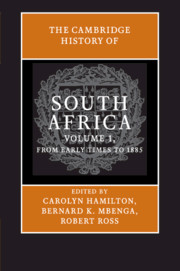Book contents
- Frontmatter
- 1 The Production of Preindustrial South African History
- 2 The Appearance of Food Production in Southern Africa 1,000 to 2,000 Years Ago
- 3 Farming Communities of the Second Millennium: Internal Frontiers, Identity, Continuity and Change
- 4 Khoesan and Immigrants: The Emergence of Colonial Society in the Cape, 1500–1800
- 5 Turbulent Times: Political Transformations in the North and East, 1760s–1830s
- 6 From Slave Economy to Settler Capitalism: The Cape Colony and Its Extensions, 1800–1854
- 7 From Colonial Hegemonies to Imperial Conquest, 1840–1880
- 8 Transformations in Consciousness
- Index
- References
7 - From Colonial Hegemonies to Imperial Conquest, 1840–1880
Published online by Cambridge University Press: 28 September 2010
- Frontmatter
- 1 The Production of Preindustrial South African History
- 2 The Appearance of Food Production in Southern Africa 1,000 to 2,000 Years Ago
- 3 Farming Communities of the Second Millennium: Internal Frontiers, Identity, Continuity and Change
- 4 Khoesan and Immigrants: The Emergence of Colonial Society in the Cape, 1500–1800
- 5 Turbulent Times: Political Transformations in the North and East, 1760s–1830s
- 6 From Slave Economy to Settler Capitalism: The Cape Colony and Its Extensions, 1800–1854
- 7 From Colonial Hegemonies to Imperial Conquest, 1840–1880
- 8 Transformations in Consciousness
- Index
- References
Summary
The period covered by this chapter is marked by the expansion of power exercised by Europeans or their descendants in South Africa. In the Cape Colony, power shifted from a series of military governors to local officials elected under a nonracial, qualified franchise. A more original form of government emerged in Natal, where representatives of the metropolitan government ruled the African population while colonists of European descent exercised only limited political powers. In the interior, Boer settlers built two fragile republics on the basis of a racial franchise limited to white men. The growth and expansion of these very different settler states was conditional upon the conquest of the original inhabitants and the alienation of their land. Wool-farming and plantation agriculture, and later the mining of diamonds in the interior, brought a new urgency to the development of the British colonies and to demands for land and labor. The swell of change was carried far beyond the confines of British rule as people adopted new identities more suitable to their changed situation. Race grew into a primary factor of social classification, belonging, and exclusion and, over time, came to be regarded by many as a scientific means of explanation. The delineation and transcription of languages divided people into ethnic groups that rapidly developed their own values, practices, and histories. During this period, Christianity spread up the coast and into the interior. Many converts adopted the Christian beliefs and practices brought to Africa from Europe whereas others adapted them to local conditions. In some areas class-consciousness grew in importance whereas gender relations, based on the social practices associated with sexual difference, underwent extensive change. As the labor market expanded, many young African men returned home with wages and freedoms that challenged the gerontocratic structure of rural life.
- Type
- Chapter
- Information
- The Cambridge History of South Africa , pp. 319 - 391Publisher: Cambridge University PressPrint publication year: 2009
References
- 2
- Cited by



